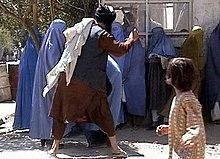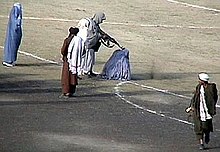Taliban
The Taliban is a large Sunni Islamic fundamentalist militant group operating in Afghanistan. The group formed the government of Afghanistan from 1996 to 2001 and took military control of most of Afghanistan again in August 2021. Since the Fall of Kabul on 15 August 2021, the Taliban again has full control of Afghanistan.
| Taliban | |
|---|---|
| طَالِبَانْ (ṭālibān) | |
 Flag of the Taliban, also used as the flag of Afghanistan | |
| Founders | |
| Supreme leaders |
|
| Governing body | Leadership Council |
| Dates of operation |
|
| Group(s) | Primarily Pashtuns;[1][2] minority Tajiks and Uzbeks[3][4] |
| Headquarters | Kandahar (1994–2001; 2021–present) |
| Active regions | Afghanistan |
| Ideology | Majority: |
| Size | Core strength 130,000 (2022 self-claim)[26] |
| Allies | Subgroups
|
| Opponents | State and intergovernmental opponents
|
| Battles and wars |
|
| Designated as a terrorist group by | |
| Website | alemarahenglish |


History




In 1994, the Taliban started a government in southern Afghanistan called the Islamic Emirate of Afghanistan. The first leader of the Taliban was Mullah Mohammed Omar.
The Taliban governed Afghanistan between 1996 and 2001. During this time, its leaders put in place the strictest forms of Sharia law ever seen in the Muslim world.[79] Much criticism of the Taliban came from important Muslim scholars.[80] For example, if a thief were caught stealing something the Taliban would cut off one of his hands so that he does not use it to steal again, no matter what it was that he stole. Many criminals were put to death quickly and without a fair trial and were executed in public. Anyone who refused to follow the law was considered a non-Muslim enemy. Every male had to go to mosque for prayer (except Afghan non-Muslims) during praying times, which is five times per day.
The Taliban became known around the world for their very bad treatment of women and girls, denying them human rights.[81] They also treated the Shia Muslim (who they consider heretics) and non-Muslim minorities (who are Hindus and Sikhs) very badly. Every form of art, music and entertainment was strictly banned under their rule, and sculptures, paintings, photos, cameras, televisions, etc. were destroyed. The Taliban also did cultural genocide when they destroyed the Buddhas of Bamiyan in February and March 2001 because they considered the display of human and animal figures a sin.[82]
After the September 11 attacks in 2001, the United States invaded Afghanistan. The Taliban had been giving its ally al-Qaeda a safe base from which to operate. The United States government said that Osama bin Laden and al-Qaeda members did the attacks in the U.S. The Taliban asked the U.S. for proof of this before it would arrest them. The invasion aimed to remove the Taliban government from power, destroy al-Qaeda, and capture bin Laden. After losing power in 2001, the Taliban had its headquarters in Pakistan.[83]
In February 2020, the United States and the Taliban signed the Doha Agreement that would remove all U.S. troops from Afghanistan by May 1, 2021.[84] President of the United States Joe Biden said that the U.S. exit from Afghanistan would start on May 1, 2021 and end by September 11, 2021, which would be exactly 20 years since the September 11 attacks.[85]
On 15 August 2021, the Taliban captured Kabul and the Afghan government collapsed, with the Taliban taking control of most of Afghanistan. On 30 August 2021, the Taliban took full control of the country and ending the War in Afghanistan after the evacuations from Afghanistan ended.[86]
Ideology
Economy
It is estimated that in 2020 the Taliban had an income of $1.6 billion, mostly from drugs, mining, extortion and taxes, donations (or gifts) and exports.[98][99]
The Taliban have financed themselves mostly from selling illegal drugs.[100] A big part of the opium sold worldwide comes from Afghanistan: The Taliban grow the poppies (which are used to make opium). Another part of their income is racketeering: they offer "protection" in exchange for money. They also take taxes (following Islamic law, as they claim) in the areas they control. Finally, there's financial support in the form of donations from abroad. Most of the donations come from countries around the Persian Gulf; many donations also come from Pakistan.
An article in 2021 in the Wall Street Journal said that there is [financing or] "funding from the opium trade and extortion schemes [... for] Taliban operations".[101]
Taliban views on society
In the past, the Taliban had views on society that are stricter than those of many other Islamic countries:[102][103][104][105][106]
They had the following rules for girls and women:[107]
- Starting at age eight, girls and women must not be in contact with men who are not their direct family or who they are not married with.
- Women must not be seen in public without wearing a burqa or being accompanied by a male family member.
- They must not wear shoes with high heels so that no man can hear when they walk and be sexually aroused by the sound[source?]
- They must not speak loudly in public so no stranger can hear their voice.[108]
- All windows on the ground floor and the first floor of the house must be sealed (or walled in) so that no one can see a woman in her apartment when he passes by on the street
- Taking photographs of women or making movies showing women is forbidden. This also applies to showing pictures of women in magazines, books, newspapers, or shops. This also applies to the home.
- Placenames that contain the word "woman" must be changed (That way, a "women's garden" became a "spring garden")
- Women are forbidden from using the balcony or garden of the place where they live
- Women must not have access to (or be featured in) radio, TV, or the media. They must not be allowed to attend public assemblies or meetings.
- Women can get an education until they reach puberty; afterward, they should get married and care for their children
Human trafficking
Several Taliban and al-Qaeda commanders ran a network of human trafficking. They abducted girls and women from ethnic minorities. They sold them into sex slavery in Afghanistan and Pakistan.[109] Time magazine writes: "The Taliban often argued that the restrictions they placed on women were a way of [worshipping] and protecting the opposite sex. The behavior of the Taliban during the six years they expanded their rule in Afghanistan made a mockery of that claim."[109]
The targets for human trafficking were mostly women from non-Pashtun ethnic groups in Afghanistan. Some women preferred to commit suicide rather than become slaves. During one Taliban and al-Qaeda offensive in 1999 in the Shomali Plains alone, more than 600 women were kidnapped.[109] Arab and Pakistani al-Qaeda militants, with local Taliban forces, forced them into trucks and buses.[109] Time magazine writes: "The trail of the missing Shomali women leads to Jalalabad, not far from the Pakistan border. There, according to eyewitnesses, the women were penned up inside Sar Shahi camp in the desert. The more desirable among them were selected and taken away. Some were trucked to Peshawar with the apparent complicity of Pakistani border guards. Others were taken to Khost, where bin Laden had several training camps." Officials from relief agencies say the trail of many of the vanished women leads to Pakistan, where they were sold to brothels or into private households to be kept as slaves.[109]
Not all Taliban commanders took part in human trafficking. Many were opposed to the practice. Nuruludah, a Taliban commander, is quoted as saying that in the Shomali Plains, he and ten of his men freed some women whom Pakistani members of al-Qaeda were abducting. In Jalalabad, local Taliban commanders freed women that Arab members of al-Qaeda were holding in a camp.[109]
Taliban violence against civilians
In their attacks, the Taliban also target civilians in Afghanistan. According to a report by the United Nations, the Taliban were responsible for over 76% of civilian casualties in 2009.[110] In 2010, the Taliban were again responsible for over three-quarters of the civilian casualties.[111] Civilians are targets of Taliban attacks twice as often as forces of the Afghan government or troops of ISAF.[111]
In 2011, the Afghan Independent Human Rights Commission (AIGRC) said that Taliban fighters targeting civilians were a "war crime".[112] Religious leaders condemned the attacks on civilians, saying they were against Islamic ethics.[112]
Also in 2011, human rights organisations pressed the International Criminal Court in Den Haag to start investigations into whether the Taliban committed war crimes.[111]
Human rights abuses
When they took control of the country, the Taliban promised an amesty to the fighters and officials of the former government. At the end of 2021, a few months after the Taliban took control, Human Rights Watch and other organisations have documented summary executions of these people.[113] The United States, the European Union, and several other countries have therefore told the Taliban that they should keep the promise they gave.[113][114]
Relationship with other countries
- Russia has had meetings with the Taliban regularly over the last years (since August 2021).[115] Russia's ambassador (Dmitrij Zjirnov) had a meeting - in Afghanistan - with representatives from Taliban on 18 August 2021.[116]
- United States. On 23 August 2021, the chief of CIA met with a member of the [ middle managment] of Taliban (Abdul Ghani Baradar); the CIA chief is the highest ranking member of Biden administration to have met with Taliban.[117]
- Norway has had contact with the Taliban as far back as 2007.[118] For several years (as of 2021), Norwegian diplomats have been in contact with the Taliban, at the (peace talks or) peace process in Doha (Qatar); as of 2021's fourth quarter, Norway still has diplomats at the peace talks in Doha.[119][120]
Relationship with militant groups (outside Afghanistan)
Tehrik-i-Taliban
Tehrik-i-Taliban Pakistan operates in northwestern Pakistan and is sometimes called the Pakistani Taliban, but they are a separate group.
Before the beginning of Tehrik-i-Taliban, some of its (later) leaders and fighters were part of the 8,000 Pakistani militants fighting in the War in Afghanistan (1996–2001) and the War in Afghanistan (2001–present) against the United Islamic Front and NATO forces.[121] Most of them come from the Pakistani side of the Af-Pak border regions. After the fall of the Afghan Taliban in late 2001, most Pakistani militants, including members of today's TTP, escaped (home) to Pakistan.
Peace talks
At the peace talks in Doha, there is little or no progress (as of 2021's third quarter).[122]
Leader (or Supreme Commander)
- Hibatullah Akhundzada (since 2016)[123]
Related pages
- Panjshir resistance
- Tehrik-i-Taliban Pakistan - Sometimes called Pakistani Taliban. Unrelated group in Pakistan.
- Wahida Amiri, the librarian who stood up to the Taliban
Bibliography
- Griffiths, John C. (2001), Afghanistan: a history of conflict, London: Carlton Books ISBN 1-84222-597-9
- Rashid, Ahmed (2000), Taliban: militant Islam, oil and fundamentalism in central Asia, New Haven: Yale University Press ISBN 0-300-08340-8
References
Further reading
- The IMF Acts Against the Taliban (Aug. 18, 2021). WSJ.com
Other weblinks
- Afghanistan: A journey through Taliban country - a half-hour documentary, by France 24, Published 11.6.2021